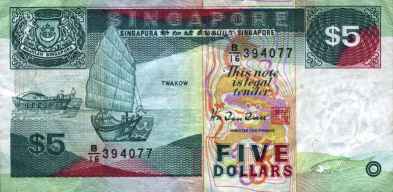

| Since 1 November 1999. Updated 1 May 2004 |
 
|
            
|
|
   If you read my story from Hong Kong you know that one day I would return to Asia. That day was on July 20th, 1999, when I arrived to Singapore. Some people told me not to go there because there is not so much to see, but there is a lot to see in Singapore, and I don't regret for a second I went there. The city itself is very complex and has a great variation of environments so different from each other. Singapore is like a pot with different cultures mixed together and that is what gives the city it's soul, even though that soul shows itself differently whether you visit e.g. Chinatown or Little India or Arab Street. All people here is very friendly to each other and to foreigners, something I not always found in other places I've been visiting during my trips. One thing I have with me back home is new friends, and it was a great pleasure to come back to Singapore again in August 2000, and later again together with my girlfriend.
If you read my story from Hong Kong you know that one day I would return to Asia. That day was on July 20th, 1999, when I arrived to Singapore. Some people told me not to go there because there is not so much to see, but there is a lot to see in Singapore, and I don't regret for a second I went there. The city itself is very complex and has a great variation of environments so different from each other. Singapore is like a pot with different cultures mixed together and that is what gives the city it's soul, even though that soul shows itself differently whether you visit e.g. Chinatown or Little India or Arab Street. All people here is very friendly to each other and to foreigners, something I not always found in other places I've been visiting during my trips. One thing I have with me back home is new friends, and it was a great pleasure to come back to Singapore again in August 2000, and later again together with my girlfriend.
 Singapore, Republic of, independent city-state in South East Asia, comprising one major island and 59 small adjacent islets, located off the southern tip of the Malay Peninsula. Singapore Island, the major island, is separated from Malaysia to the north by the narrow Johor Strait. On the south, it is separated from the Riau archipelago of Indonesia by Singapore Strait, an important shipping channel linking the Indian Ocean to the west with the South China Sea on the east. The city of Singapore is at the south-eastern end of the island; it is one of the most important port cities and commercial centres of South East Asia. The total area of the republic is 640 sq km (247 sq mi).
Population
Population Characteristics Religion in Singapore reflects ethnic divisions. Of the Chinese population, 68 per cent (54 per cent of the overall population) practises various combinations of Buddhism, Daoism, and the philosophical creed of Confucianism; and 14 per cent practises Christianity, mostly Roman Catholicism. The Malay population is 98 per cent Muslim. Of the Indian population, 53 per cent practises Hinduism, 26 per cent practises Islam, 13 per cent Christianity, and 7 per cent Sikhism, Jainism, or other creeds. There are also small groups of Zoroastrians and Jews. The Republic of Singapore has four official languages - English, Mandarin Chinese, Malay, and Tamil. At least eight other dialects of the Chinese language are in use, most of them mutually unintelligible. English is the language of administration and education.
The port city of Singapore was created as an entrepôt, and the Republic has built upon the native commercial tradition. One of the economic "tigers" of Asia, Singapore has enjoyed economic growth rates that averaged 8.5 per cent per annum from 1966 and have risen even higher in the 1990s, and has one of the highest standards of living of any country in the region. The historic emphasis on international trade has diversified into extensive local manufacturing, mostly capital-intensive light industry, and financial services. In 2001 the gross national product was estimated at US$86,000 million, or US$20,730 per capita. The annual budget for the financial year 2000 comprised US$24,200 million in revenue and US$17,500 million in expenditure.
Currency and Banking
Commerce and Trade
Government Executive and Legislature The head of state of the Republic of Singapore is a president, elected to a six-year term. The president used to be elected by parliament, but by a 1991 constitutional amendment, the president is now elected directly by the people, with increased powers. The prime minister, appointed by the president, is head of government and in practice enjoys more power than the president. Legislative power is vested in a one-house parliament, which in 1997 included 83 popularly elected members. In addition to elected members, the parliament may also contain up to 6 members nominated by the president and up to 6 members appointed from opposition political parties. The purpose of the nominated and appointed members is to ensure parliament represents a wide range of views. Nominated members are chosen from distinguished professionals or public servants in the general public. All members of parliament serve five-year terms.

Political Parties S. R. Nathan became the sixth president of Singapore when he was sworn in on September 1, 1999. Nathan was returned unopposed without an election when the election committee ruled on August 18 that the two other candidates did not meet the criteria for the certificate of eligibility-candidates must have proven financial and executive experience in government or industry. A former intelligence chief, Nathan has served as Singapore's high commissioner to Malaysia and as ambassador to the United States, and is the protégé of senior minister Lee Kuan Yew, a former prime minister who remains strongly influential in Singaporean politics. Opposition politicians expressed dismay at the government's decision not to hold an election, arguing that Singaporeans should have been allowed to vote even on a single government-appointed candidate. Nathan succeeds Ong Teng Cheong, Singapore's first popularly elected president, who declined to run for a second term due to opposition within the government at his attempts to clearly define an independent role for the presidency. In response to the latter debate, Lee recently declared that the presidency was largely a ceremonial post.
Judiciary
History
European Colonization During World War II, Singapore was captured and occupied by Japanese forces in February 1942 in a week-long campaign that followed their conquest of British Malaya, despite its supposed status as the impregnable fortress of the British Empire in the Far East. As the British retreated, they only partially destroyed the causeway that linked Singapore with the Malay peninsula. Thus the invaders had easy access to the great port; however, important installations, including the world's largest floating dry dock, were destroyed to deny them to the Japanese. Anti-Japanese resistance by Singaporeans, including such notable heroes as Lim Bo Seng, was met with stern repression. On September 6, 1945, the city was liberated by British troops. The following year Singapore was made a separate Crown Colony from Malaya. In 1955 responsibility for domestic policy passed to the locally elected ministers and legislative assembly, and on June 3, 1959, Singapore became a self-governing state in the Commonwealth of Nations. On September 16, 1963, Singapore, Malaya, North Borneo (renamed Sabah), and Sarawak united to form Malaysia.
The Republic
From 1959 to 1990 executive power was exercised by Prime Minister Lee Kuan Yew. His People's Action Party captured arliament in every election from 1968 onwards, and he governed with a firm hand. Policies masterminded by Hon Sui Sen and other government technocrats caused the Singaporean economy to grow by an average of 8.5 per cent from 1966 to 1990, making Singapore one of the economic "tigers" of Asia. Singapore was changed from a distribution entrepôt to a manufacturing centre, specializing in skill- and capital- intensive industries and high technology, and a financial centre. Government social and political policies were paternalistic, tending to confirm the ruling position of the PAP in Singapore. Lee Kuan Yew and his fellow officials answered outside criticism by highlighting Singapore's economic strength, its delicate social balance between various races, and its vulnerability to the political and economic ambitions of its neighbours. Fearing Communist subversion, Lee was a staunch supporter of US policies in South East Asia and in August 1967 made Singapore a founder member of the Association of South East Asian Nations (ASEAN). In 1971, after the final withdrawal of British troops from Singapore, he led Singapore into a defence alliance with Australia, Britain, Malaysia, and New Zealand. After the end of the Vietnam War he adopted a more conciliatory attitude towards the Communist regimes in the area, finally extending diplomatic recognition to China in 1990. Nair resigned the presidency in 1985 and was replaced by Wee Kim Wee. Lee resigned in 1990 and designated Goh Chok Tong as his successor, retaining a position as senior minister in the government.
The 1990s In February 1995 the disclosure of vast losses on unsupervised tradings made by a Singapore-based derivatives trader caused the collapse of his employer Barings, the oldest merchant banking group in the United Kingdom. Relations between Singapore and the Philippines were thrown into crisis by the execution on March 17, 1995, of a Filipino maid convicted of murdering a fellow domestic worker and a child in Singapore; the Singaporean authorities rejected pleas from the Philippines for a stay of execution. In December 1995 a Singapore court sentenced Nick Leeson, the trader responsible for the collapse of Barings, to six years in prison for deception.
The flight of the opposition Workers' Party candidate Tang Liang Hong to Malaysia after the election, citing death threats and facing defamation threats from several figures including Lee Kuan Yew, led to a worsening of relations between the two countries in March 1997 after Lee criticized Tang's refuge, the Malaysian state of Johor. A Singapore court ordered Tang to pay a record S$8.08 million (US$5.65 million) in libel damages to Goh and other senior PAP members in April 1997, but in September another defamation trial against a Workers' Party official led to a considerable reduction in the libel damages asked for by Goh and criticism of the handling of the case. In November the Singapore Court of Appeal halved the damages Tang was liable to pay. Singapore escaped significant damage from the financial crisis during 1997. In February 1998 the government announced liberalizing financial reforms to improve Singapore's competitiveness; it also banned political parties from access to television time and from making promotional videos.
|